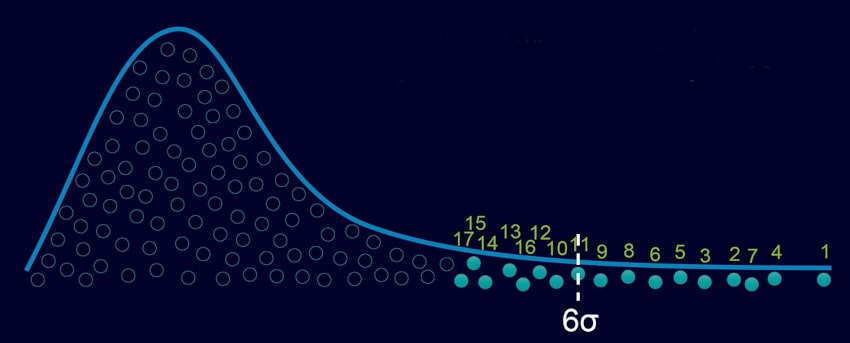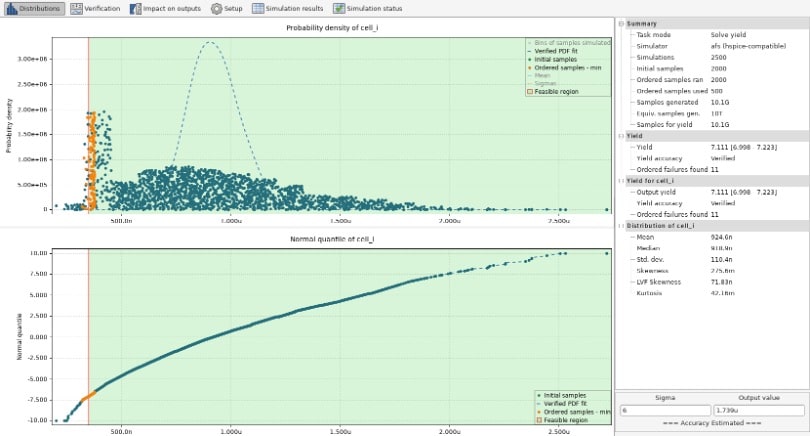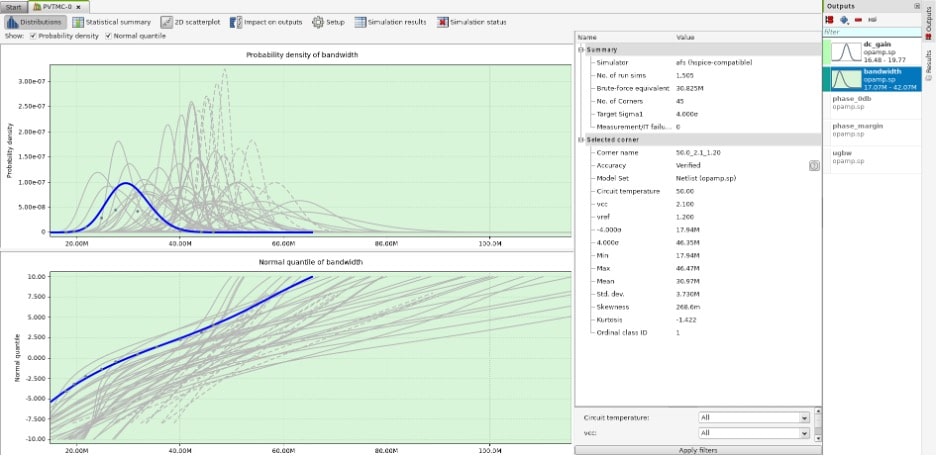I’ve been following Solido as a start-up EDA vendor since 2005, then they were acquired by Siemens in 2017. At the recent User2User event there was a presentation by Kwonchil Kang, of Samsung Electronics on the topic, ML-enabled Statistical Circuit Verification Methodology using Solido. For high reliability circuits there is a high-sigma requirement, and 6 sigma equates to 10 failures per 10,135,946,920 samples, or simulations. Using multiple Process, Voltage and Temperature (PVT) corners creates even more simulations. Using a brute-force approach to reach high-sigma by Monte Carlo simulations simply takes too much time.
There is a reduced Monte Carlo approach that tries to scale to 6-sigma, but for a bandgap reference circuit example with 36 PVT corners it requires 3,000 simulations per PVT corner, or 108,000 simulations for all 36 PVT corners, and the limited accuracy comes as long tail or non-gaussian characteristics are introduced.
The Solido approach uses Artificial Intelligence (AI) for variation-aware design and verification with Solido Variation Designer, and there are two components:
- PVTMC Verifier – finds worst-case corner for target sigma and design sensitivities to variation
- High-Sigma Verifier – High-sigma verification 1,000 to 1,000,000,00 faster than brute-force simulation
There are several steps to the AI algorithm used in the Solido tools, and the first step is to generate Monte Carlo samples, but don’t simulate them. Next, simulate initial samples, and then sort all of the samples and simulate them in order. Simulating even more samples will then capture the true yield at a target sigma.

With this Solido AI approach, and the resulting Probability Density Function (PDF) would look like the example below:

Probability Density Function
The dashed blue line is the verified PDF fit. Green dots are the initial samples, and dark dots the Monte Carlo results. The orange dots are ordered samples.
For the actual bandgap reference circuit described in the presentation, Solido Variation Designer achieved verification equivalent to 10 billion brute-force simulations in just 24,100 simulations translating to a speed-up of some 415,000X.
PVTMC Verifier covers all PVT corners and runs Monte Carlo in a way that requires only a few hundred simulations to capture the target sigma, thus reducing the number of simulations across the corners. The results are accurate as there are no extrapolations used or Gaussian assumptions, because it’s using real simulations at the target sigma. It’s covering all PVTs in a single run of the tool.

Inside of the PVTMC Verifier it’s identifying ordinals classes for all PVTs, capturing a distribution for each class, then verifying distributions within known classes. On the bandgap reference circuit described in the presentation, PVTMC Verifier ran a 6-sigma verification across all 36 PVTs in just 11,000 simulations, a speed-up of 32,000,000 compared to brute-force Monte Carlo.
The tool flow for using Solido AI is that a circuit netlist is run through PVTMC Verifier to select the worst-case statistical points, simulates the samples at multiple scales, observe the response to a change in scale, then it builds a model to predict the unscaled yield estimate. These first-pass results are then sent to the high-sigma verifier which runs initial samples until model building is successful, uses AI to generate Monte Carlo samples, then runs tail samples until the result is verified.
Using the Solido AI methodology required only 300 simulations per PVT with PVTMC Verifier (10,800 simulations) plus 20,000 simulations with High-Sigma Verifier, so a total of 34,900 simulations. The accuracy matched brute-force Monte Carlo, however the results completed 10,000,000X faster
Summary
At Samsung they are using Solido AI technology to achieve their goals of high-sigma verification across IC applications, while having much shorter run times than using brute-force Monte Carlo simulations. They used PVTMC Verifier to give first-pass results across all PVTs, then followed with High-Sigma Verifier for the final verification on critical and worst-case PVTs.
Related Blogs
- EDA in the Cloud with Siemens EDA at #59DAC
- DAC 2021 – Taming Process Variability in Semiconductor IP
- Machine Learning Applied to IP Validation, Running on AWS Graviton2
- From Silicon To Systems
- Siemens EDA Acquires an IP Validation Tool for standard cells, IO and Hard IP
- Siemens EDA Wants to Help you Engineer a Smarter Future Faster






Comments
There are no comments yet.
You must register or log in to view/post comments.